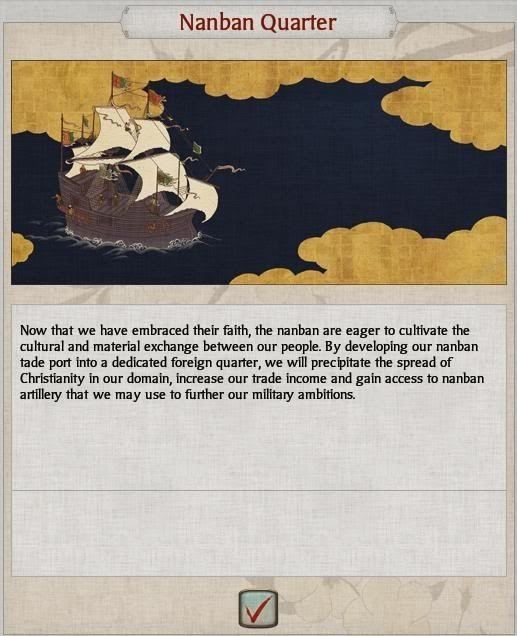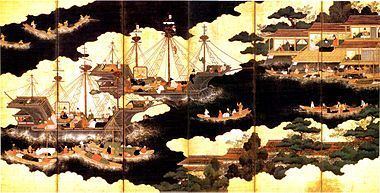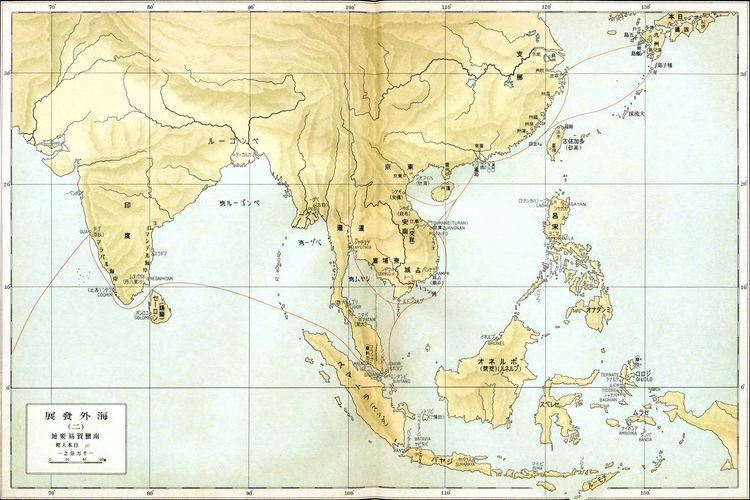Period 1543 – 1641 | ||
 | ||
Let s play shogun 2 otomo campaign legendary part 36 nanban trade ship
The Nanban trade (南蛮貿易, Nanban bōeki, "Southern barbarian trade") or the Nanban trade period (南蛮貿易時代, Nanban bōeki jidai, "Southern barbarian trade period") in the history of Japan extends from the arrival of the first Europeans – Portuguese explorers, missionaries and merchants – to Japan in 1543, to their near-total exclusion from the archipelago in 1614, under the promulgation of the "Sakoku" Seclusion Edicts.
Contents
- Let s play shogun 2 otomo campaign legendary part 36 nanban trade ship
- Ninja kore the game
- Japanese accounts of Europeans
- European accounts of Japan
- Portuguese trade in the 16th century
- Portuguese trade in Japanese slaves
- Dutch involvement
- Tanegashima guns
- Red seal ships
- Catholicism in Japan
- Other Nanban influences
- Decline of Nanban exchanges
- Usages of the word Nanban
- Timeline
- References
Nanban (南蛮, "southern barbarian") is a Sino-Japanese word, Chinese Nánmán, originally referring to the peoples of South Asia and Southeast Asia. In Japan, the word took on a new meaning when it came to designate the Portuguese, who first arrived in 1543, and later other Europeans.

Ninja kore the game
Japanese accounts of Europeans

Following contact with the Portuguese on Tanegashima in 1542, the Japanese were at first rather wary of the newly arrived foreigners. The culture shock was quite strong, especially due to the fact that Europeans were not able to understand the Japanese writing system nor accustomed to using chopsticks.

They eat with their fingers instead of with chopsticks such as we use. They show their feelings without any self-control. They cannot understand the meaning of written characters. (from Boxer, Christian Century).
The Japanese were introduced to several new technologies and cultural practices (so were the Europeans to Japanese, see Japonism), whether in the military area (the arquebus, European-style cuirasses, European ships), religion (Christianity), decorative art, language (integration to Japanese of a Western vocabulary) and culinary: the Portuguese introduced the tempura and above all the valuable refined sugar, creating nanbangashi (南蛮菓子), "southern barbarian confectionery", with confectioneries like castella, konpeitō, aruheitō, karumera, keiran sōmen, bōro and bisukauto.
Many foreigners were befriended by Japanese rulers, and their ability was sometimes recognized to the point of promoting one to the rank of samurai (William Adams), and giving him a fief in the Miura Peninsula, south of Edo.
European accounts of Japan
Renaissance Europeans were quite fond of Japan's immense richness in precious metals, mainly owing to Marco Polo's accounts of gilded temples and palaces, but also due to the relative abundance of surface ores characteristic of a volcanic country, before large-scale deep-mining became possible in Industrial times. Japan was to become a major exporter of copper and silver during the period.
Japan was also noted for being much more populated and urbanized than any Western country (in the 16th century, Japan had 26 million inhabitants against 16 million for France and 4.5 million for England). Buddhist schools in Japan were also larger than universities in the West such as Salamanca or Coimbra. At the time, some Europeans became quite fascinated with Japan, Alessandro Valignano even writing that the Japanese "excel not only all the other Oriental peoples, they surpass the Europeans as well".
Early European visitors noted the quality of Japanese craftsmanship and metalsmithing. This stems from the fact that Japan itself is rather poor in natural resources found commonly in Europe, especially iron. Thus, the Japanese were famously frugal with their consumable resources; what little they had they used with expert skill though because of this, they had not reached European levels.
Japanese military prowess was also well noted. "A Spanish royal decree of 1609 specifically directed Spanish commanders in the Pacific 'not to risk the reputation of our arms and state against Japanese soldier.'" (Giving Up the Gun, Noel Perrin). Troops of Japanese samurai were later employed in the Maluku Islands in Southeast Asia by the Dutch to fight off the English.
Portuguese trade in the 16th century
Soon after the first contacts in 1543, Portuguese ships started to arrive in Japan. At that time, there were already trade exchanges between Portugal and Goa (since around 1515), consisting of 3 to 4 carracks leaving Lisbon with silver to purchase cotton and spices in India. Out of these, only one carrack went on to China in order to purchase silk, also in exchange for Portuguese silver.
Accordingly, the cargo of the first Portuguese ships (usually about 4 smaller-sized ships every year) arriving in Japan almost entirely consisted of Chinese goods (silk, porcelain). The Japanese were very much looking forward to acquiring such goods, but had been prohibited from any contact with China by the Emperor of China, as a punishment for Wokou pirate raids. The Portuguese therefore found the opportunity to act as intermediaries in Asian trade.
With the foundation of the port of Nagasaki, through the combined initiatives of converted daimyo Ōmura Sumitada and his Portuguese friend and confessor, Jesuit missionary Gaspar Vilela, in 1571, the extent of Portuguese trade and influence in Japan, and particularly in Kyūshū, would increase dramatically for the next thirty on years, even furthering the depth of its foothold on the strategic harbour, after having assisted Sumitada in repelling an attack on the port by the Ryūzōji clan in 1578, which in turn led Sumitada to cede Nagasaki "in perpetuity" to the Society of Jesus two years later.
From the time of the acquisition of Macau in 1557, and their formal recognition as trade partners by the Chinese, the Portuguese Crown started to regulate trade to Japan, by selling to the highest bidder the annual "Capitaincy" to Japan, in effect conferring exclusive trading rights for a single carrack bound for Japan every year. The carracks were very large ships, usually between 1000 and 1500 tons, about double or triple the size of a regular galleon or a large junk.
That trade continued with few interruptions until 1638, when it was prohibited on the ground that the ships were smuggling priests into Japan.
Portuguese trade was progressively more and more challenged by Chinese smugglers on junks, Japanese Red Seal Ships from around 1592 (about ten ships every year), Spanish ships from Manila from around 1600 (about one ship a year), the Dutch from 1609 and the English from 1613 (about one ship per year).
Portuguese trade in Japanese slaves
After the Portuguese first made contact with Japan in 1543, a large scale slave trade developed in which Portuguese purchased Japanese as slaves in Japan and sold them to various locations overseas, including Portugal itself, throughout the sixteenth and seventeenth centuries. Many documents mention the large slave trade along with protests against the enslavement of Japanese. Japanese slaves are believed to be the first of their nation to end up in Europe, and the Portuguese purchased large numbers of Japanese slave girls to bring to Portugal for sexual purposes, as noted by the Church in 1555. King Sebastian feared that it was having a negative effect on Catholic proselytization since the slave trade in Japanese was growing to massive proportions, so he commanded that it be banned in 1571
Japanese slave women were sold as concubines to black African crewmembers, along with their European counterparts serving on Portuguese ships trading in Japan, as mentioned by Luis Cerqueira, a Portuguese Jesuit, in a 1598 document. Japanese slaves were brought by the Portuguese to Macau, where some of them not only ended up being enslaved to Portuguese, but as slaves to other slaves, with the Portuguese owning Malay and African slaves, who in turn owned Japanese slaves of their own.
The imperial regent, Toyotomi Hideyoshi was so disgusted that his own Japanese people were being sold en masse into slavery on Kyushu, that he wrote a letter to Jesuit Vice-Provincial Gaspar Coelho on 24 July 1587 to demand the Portuguese, Siamese, and Cambodians stop purchasing and enslaving Japanese and return Japanese slaves who ended up as far as India. Toyotomi blamed the Portuguese and Jesuits for this slave trade and banned Christian proselytizing as a result.
Some Korean slaves were bought by the Portuguese and brought back to Portugal from Japan, where they had been among the tens of thousands of Korean prisoners of war transported to Japan during the Japanese invasions of Korea (1592–98). Historians pointed out that at the same time Hideyoshi expressed his indignation and outrage at the Portuguese trade in Japanese slaves, he himself was engaging in a mass slave trade of Korean prisoners of war in Japan. Japanese Christian Daimyos were mainly responsible for selling to the Portuguese their fellow Japanese. Japanese women and Japanese men, Javanese, Chinese, and Indians were all sold as slaves in Portugal. Macau received an influx of African slaves, Japanese slaves as well as Christian Korean slaves who were bought by the Portuguese from the Japanese after they were taken prisoner during the Japanese invasions of Korea (1592–98) in the era of Hideyoshi.
Fillippo Sassetti saw some Chinese and Japanese slaves in Lisbon among the large slave community in 1578, although most of the slaves were blacks.
The Portuguese "highly regarded" Asian slaves like Chinese and Japanese much more "than slaves from sub-Saharan Africa". The Portuguese attributed qualities like intelligence and industriousness to Chinese and Japanese slaves which is why they favored them more.
In 1571 a law was passed by Portugal banning the selling and buying of Chinese and Japanese slaves.
Dutch involvement
The Dutch, who, rather than "Nanban" were called "Kōmō" (Jp: 紅毛, lit. "Red Hair") by the Japanese, first arrived in Japan in 1600, on board the Liefde ("liefde" meaning "love"). Their pilot was William Adams, the first Englishman to reach Japan.
In 1605, two of the Liefde's crew were sent to Pattani by Tokugawa Ieyasu, to invite Dutch trade to Japan. The head of the Pattani Dutch trading post, Victor Sprinckel, refused on the ground that he was too busy dealing with Portuguese opposition in Southeast Asia. In 1609 however, the Dutchman Jacques Specx arrived with two ships in Hirado, and through Adams obtained trading privileges from Ieyasu.
The Dutch also engaged in piracy and naval combat to weaken Portuguese and Spanish shipping in the Pacific, and ultimately became the only westerners to be allowed access to Japan from the small enclave of Dejima after 1638 and for the next two centuries.
Tanegashima guns
The Japanese were interested in Portuguese hand-held guns. The first two Europeans to reach Japan in the year 1543 were the Portuguese traders António da Mota and Francisco Zeimoto (Fernão Mendes Pinto claimed to have arrived on this ship as well, but this is in direct conflict with other data he presents), arriving on a Chinese ship at the southern island of Tanegashima where they introduced hand-held guns for trade. The Japanese were already familiar with gunpowder weaponry (invented by, and transmitted from China), and had been using basic Chinese originated guns and cannon tubes called "Teppō" (鉄砲 "Iron cannon") for around 270 years before the arrival of the Portuguese. In comparison, the Portuguese guns were light, had a matchlock firing mechanism, and were easy to aim. Because the Portuguese-made firearms were introduced into Tanegashima, the arquebus was ultimately called Tanegashima in Japan. At that time, Japan was in the middle of a civil war called the Sengoku period (Warring States period).
Within a year after the first trade in guns, Japanese swordsmiths and ironsmiths managed to reproduce the matchlock mechanism and mass-produce the Portuguese guns. Barely fifty years later, "by the end of the 16th century, guns were almost certainly more common in Japan than in any other country in the world", its armies equipped with a number of guns dwarfing any contemporary army in Europe (Perrin). The guns were strongly instrumental in the unification of Japan under Toyotomi Hideyoshi and Tokugawa Ieyasu, as well as in the invasions of Korea in 1592 and 1597. The daimyo who initiated the unification of Japan, Oda Nobunaga, made extensive use of guns (arquebus) when playing a key role in the Battle of Nagashino, as dramatised in Akira Kurosawa's 1980 film Kagemusha (Shadow Warrior).
Red seal ships
European ships (galleons) were also quite influential in the Japanese shipbuilding industry and actually stimulated many Japanese ventures abroad.
The Shogunate established a system of commercial ventures on licensed ships called red seal ships (朱印船, shuinsen), which sailed throughout East and Southeast Asia for trade. These ships incorporated many elements of galleon design, such as sails, rudder, and gun disposition. They brought to Southeast Asian ports many Japanese traders and adventurers, who sometimes became quite influential in local affairs, such as the adventurer Yamada Nagamasa in Siam, or later became Japanese popular icons, such as Tenjiku Tokubei.
By the beginning of the 17th century, the shogunate had built, usually with the help of foreign experts, several ships of purely Nanban design, such as the galleon San Juan Bautista, which crossed the Pacific two times on embassies to Nueva España (Mexico).
Catholicism in Japan
With the arrival of the leading Jesuit Francis Xavier in 1549, Catholicism progressively developed as a major religious force in Japan. Although the tolerance of Western "padres" was initially linked to trade, Catholics could claim around 200,000 converts by the end of the 16th century, mainly located in the southern island of Kyūshū. The Jesuits managed to obtain jurisdiction over the trading city of Nagasaki.
The first reaction from the kampaku Hideyoshi came in 1587, when he promulgated the interdiction of Christianity and ordered the departure of all "padres". This resolution was not followed upon however (only 3 out of 130 Jesuits left Japan), and the Jesuits were essentially able to pursue their activities. Hideyoshi had written that
Hideyoshi's reaction to Christianity proved stronger when a shipwrecked Spanish galleon brought Franciscans to Japan in 1597. Twenty-six Christians (6 Franciscans, 17 of their Japanese neophytes, and 3 Japanese Jesuit lay brothers – included by mistake-) were crucified in Nagasaki on February 5, 1597. It seems Hideyoshi's decision was taken following encouragements by the Jesuits to eliminate the rival order, his being informed by the Spanish that military conquest usually followed Catholic proselytism, and by his own desire to take over the cargo of the ship. Although close to a hundred churches were destroyed, most of the Jesuits remained in Japan.
The final blow came with Tokugawa Ieyasu's firm interdiction of Christianity in 1614, which led to underground activities by the Jesuits and to their participation in Hideyori's revolt in the Siege of Osaka (1614–15). Repression of Catholicism became virulent after Ieyasu's death in 1616, leading to the torturing and killing of around 2,000 Christians (70 westerners and the rest Japanese) and the apostasy of the remaining 200–300,000. The last major reaction of the Christians in Japan was the Shimabara rebellion in 1637. Thereafter, Catholicism in Japan was driven underground as the so-called "Hidden Christians".
Other Nanban influences
The Nanban also had various other influences:
Decline of Nanban exchanges
After the country was pacified and unified by Tokugawa Ieyasu in 1603 however, Japan progressively closed itself to the outside world, mainly because of the rise of Christianity.
By 1650, except for the trade outpost of Dejima in Nagasaki, for the Netherlands, and some trade with China, foreigners were subject to the death penalty, and Christian converts were persecuted. Guns were almost completely eradicated to revert to the more "civilized" sword. Travel abroad and the building of large ships were also prohibited. Thence started a period of seclusion, peace, prosperity and mild progress known as the Edo period.
The "barbarians" would come back 250 years later, strengthened by industrialization, and end Japan's isolation with the forcible opening of Japan to trade by an American military fleet under the command of Commodore Matthew Perry in 1854.
Usages of the word "Nanban"
The term "Nanban" did not disappear from common usage until the Meiji restoration, when Japan decided to Westernize radically in order to better resist the West and essentially stopped considering the West as fundamentally uncivilized. Words like "Yōfu" (洋風 "western style") and "Obeifu" (欧米風 "European-American style)" replaced "Nanban" in most usages.
Still, the exact principle of westernization was Wakon-Yōsai (和魂洋才 "Japanese spirit Western talent"), implying that, although technology may be more advanced in the West, Japanese spirit is better than the West's. Hence though the West may be lacking, it has its strong points, which takes the affront out of calling it "barbarian."
Today the word "Nanban" is only used in a historical context, and is essentially felt as picturesque and affectionate. It can sometimes be used jokingly to refer to Western people or civilization in a cultured manner.
There is an area where Nanban is used exclusively to refer to a certain style, and that is cooking and the names of dishes. Nanban dishes are not American or European, but an odd variety not using soy sauce or miso but rather curry powder and vinegar as their flavoring, a characteristic derived from Indo-Portuguese Goan cuisine. Some of these dishes resemble Southeast Asian cuisines but are so heavily changed to fit Japanese tastes like ramen that they should be considered separate.
